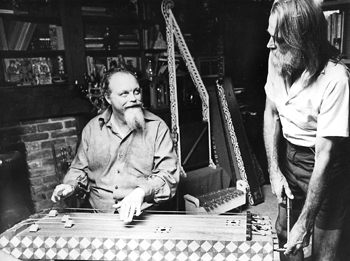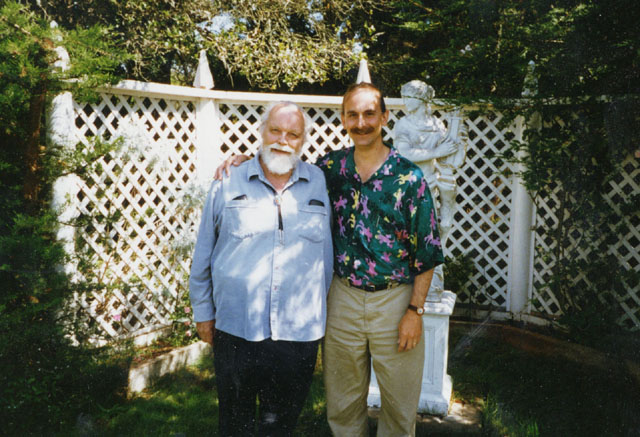

By Bill Alves
 Lou Harrison was one of the great composers of the twentieth century--a pioneer in the
use of alternate tunings, world music influences, and new instruments. Born in 1917 in Portland
Oregon, he spent much of his youth moving around Northern California before settling in San
Francisco. There he studied with the modernist pioneer of American Music, Henry Cowell, and,
while still in his twenties, composed extensively for dance and percussion. He befriended
another of Cowell's students, John Cage, and the two of them established the first concert
series devoted to new music for percussion. They composed extensively for these concerts,
including their still popular collaboration Double Music. In 1942, Harrison moved
to Los Angeles to study with the famous Arnold Schoenberg at UCLA. Steeped in the atonal
avant garde of Schoenberg's school, he moved to New York the following year, where he made
a name for himself not only as a composer, but also as a critic under the tutelage of
composer/writer Virgil Thomson. Harrison also worked at editing the scores of American
composer Charles Ives and conducted the first performance of Ives's Third Symphony (which
won Ives the Pulitzer Prize). Harrison also published a study of the music of atonal composer
Carl Ruggles, and the influence of Ruggles and Schoenberg comes through in works such as
Harrison's Symphony on G and his opera Rapunzel. However, the stress and noise
of New York led to a nervous breakdown in 1947. To help his friend recover, Cage recommended
him to Black Mountain College in rural North Carolina, where the quiet and idyllic setting
proved conducive to studies in Harrison's new interests, Asian music and tuning.
Lou Harrison was one of the great composers of the twentieth century--a pioneer in the
use of alternate tunings, world music influences, and new instruments. Born in 1917 in Portland
Oregon, he spent much of his youth moving around Northern California before settling in San
Francisco. There he studied with the modernist pioneer of American Music, Henry Cowell, and,
while still in his twenties, composed extensively for dance and percussion. He befriended
another of Cowell's students, John Cage, and the two of them established the first concert
series devoted to new music for percussion. They composed extensively for these concerts,
including their still popular collaboration Double Music. In 1942, Harrison moved
to Los Angeles to study with the famous Arnold Schoenberg at UCLA. Steeped in the atonal
avant garde of Schoenberg's school, he moved to New York the following year, where he made
a name for himself not only as a composer, but also as a critic under the tutelage of
composer/writer Virgil Thomson. Harrison also worked at editing the scores of American
composer Charles Ives and conducted the first performance of Ives's Third Symphony (which
won Ives the Pulitzer Prize). Harrison also published a study of the music of atonal composer
Carl Ruggles, and the influence of Ruggles and Schoenberg comes through in works such as
Harrison's Symphony on G and his opera Rapunzel. However, the stress and noise
of New York led to a nervous breakdown in 1947. To help his friend recover, Cage recommended
him to Black Mountain College in rural North Carolina, where the quiet and idyllic setting
proved conducive to studies in Harrison's new interests, Asian music and tuning. |
 In 1953, he
moved back to California and (then) rural Aptos, where he resided for the rest of his life.
Despite his relative isolation from the music world, in the 1950s Harrison completed a
remarkable set of works exploring new tunings and approaches to tonality, including his
Strict Songs for just intonation orchestra and chorus. In 1961, he was invited to the
East-West Music Encounter, a conference in Tokyo, which proved a leaping-off point for
extensive studies of Asian music, first in Seoul, then in Taiwan. In the 1960s he created
some of his best known works incorporating these influences, including Pacifika Rondo
and Young Caesar. In the last, an elaborate puppet opera, he used for the first time
instruments designed and built by his new life-partner, Bill Colvig.
In 1953, he
moved back to California and (then) rural Aptos, where he resided for the rest of his life.
Despite his relative isolation from the music world, in the 1950s Harrison completed a
remarkable set of works exploring new tunings and approaches to tonality, including his
Strict Songs for just intonation orchestra and chorus. In 1961, he was invited to the
East-West Music Encounter, a conference in Tokyo, which proved a leaping-off point for
extensive studies of Asian music, first in Seoul, then in Taiwan. In the 1960s he created
some of his best known works incorporating these influences, including Pacifika Rondo
and Young Caesar. In the last, an elaborate puppet opera, he used for the first time
instruments designed and built by his new life-partner, Bill Colvig.
|
 In 1975, Harrison met
K.R.T. Wasitodiningrat, familiarly known as Pak Cokro, one of the great masters of the Javanese
gamelan orchestra in that century. Pak Cokro not only instructed him in gamelan music, but also
encouraged him to compose for the ensemble. Over the next
ten years, Harrison would produce dozens of works for gamelan, often in
combinations with Western instruments, such as Philemon and Baukis (violin and gamelan),
Main Bersama-sama (horn and Sundanese gamelan), and Bubaran Robert (trumpet and
gamelan). He and Colvig built various sets of gamelan instruments, including ensembles at
colleges where Harrison taught at various times--Mills College, San Jose State University, and
Cabrillo College. In the 1980s, with the rise of interest in the "new tonality" and world music,
the world began to catch up with Lou Harrison, who by the time of his death was recorded on
dozens of CDs and was the subject of many festivals and tributes. On his way to another festival
in his honor in January 2003 in Ohio, Harrison suffered a heart attack and passed away at the age
of 85. As a composer, artist, poet, calligraphist, peace activist, Lou Harrison dedicated his
life to bringing beauty into the world, and those of us who remember his warm generosity, his
integrity of spirit, and his irrepressible joyfulness, owe a great debt of gratitude that he did. In 1975, Harrison met
K.R.T. Wasitodiningrat, familiarly known as Pak Cokro, one of the great masters of the Javanese
gamelan orchestra in that century. Pak Cokro not only instructed him in gamelan music, but also
encouraged him to compose for the ensemble. Over the next
ten years, Harrison would produce dozens of works for gamelan, often in
combinations with Western instruments, such as Philemon and Baukis (violin and gamelan),
Main Bersama-sama (horn and Sundanese gamelan), and Bubaran Robert (trumpet and
gamelan). He and Colvig built various sets of gamelan instruments, including ensembles at
colleges where Harrison taught at various times--Mills College, San Jose State University, and
Cabrillo College. In the 1980s, with the rise of interest in the "new tonality" and world music,
the world began to catch up with Lou Harrison, who by the time of his death was recorded on
dozens of CDs and was the subject of many festivals and tributes. On his way to another festival
in his honor in January 2003 in Ohio, Harrison suffered a heart attack and passed away at the age
of 85. As a composer, artist, poet, calligraphist, peace activist, Lou Harrison dedicated his
life to bringing beauty into the world, and those of us who remember his warm generosity, his
integrity of spirit, and his irrepressible joyfulness, owe a great debt of gratitude that he did.
|
Other links:
The Lou Harrison page of Other Minds, a San Francisco-based organization and festival.
Lou Harrison lists of the American Music Resource includes a discography, works list, bibliography, etc.
Interviews with Lou Harrison from SoundCircus, NewMusicBox, and Echo.
Scores of Lou Harrison are on sale from Frog Peak Music